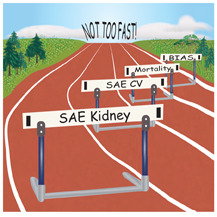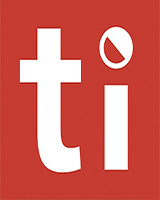This is an open-access article distributed under the terms of the Creative Commons Attribution License, which permits unrestricted use, distribution, and reproduction in any medium, provided the original work is properly cited.
NCBI Bookshelf. A service of the National Library of Medicine, National Institutes of Health.
Perry T, editor. Therapeutics Letter. Vancouver (BC): Therapeutics Initiative; 1994-.
Therapeutics Letter 98 reviews Cochrane systematic review evidence in considering whether SPRINT should change the approach to blood pressure targets. Conclusions: At the present time, lower BP targets (≤ 135/85 mmHg) have not been demonstrated to reduce mortality or total serious adverse events as compared with standard BP targets (≤ 140-160/90-100 mmHg). Careful analysis of the SPRINT trial reveals that benefits of a lower blood pressure target in high-risk nondiabetic people do not outweigh harms. Critical appraisal of systematic reviews and clinical trial reports often leads to interpretation and conclusions different from initial impressions.
Keywords:
Antihypertensive Agents, Blood Pressure, Hypertension
SPRINT
In September 2015, Systolic blood PRessure INtervention Trial (SPRINT) added a new trial that studied BP targets. It was stopped early for benefit. Results were published in November 2015.3 SPRINT randomly assigned 9361 persons with a systolic BP of 130 mmHg or higher and an increased cardiovascular risk (but without diabetes or prior stroke) to a low systolic BP target of < 120 mmHg or a standard target of < 140 mmHg. SPRINT was an open label trial conducted at 102 sites. The average achieved BP at one year in the low BP target group was 121/69 versus 136/76 mmHg in the standard BP target group. The average number of antihypertensive drugs in the low BP target group was 2.8, vs. 1.8 in the standard BP target group.
Benefits
After an average duration of 3.3 years, the primary outcome (a composite of myocardial infarction, acute coronary syndrome, stroke, acute decompensated heart failure, or death from cardiovascular causes) was decreased in the low BP target group at 5.2%, vs. 6.8% in the standard BP target group, RR 0.76 [0.65, 0.90], ARR 1.6%, NNT 63 for 3.3 years.
Harms
Specific serious adverse events classified as possibly or definitely related to the intervention were increased in the low BP target group, 4.7%, vs. 2.5% in the standard BP target group, RR 1.87 [1.50, 2.33] ARI 2.2%, NNTH 46 for 3.3 years. This was due mainly to a 1.2% absolute increase in acute kidney injury or acute renal failure in the low BP target group.
Overall effect
Total serious adverse events were appropriately defined as fatal or life-threatening events resulting in clinically significant or persistent disability, or events that required or prolonged a hospitalization. The number of people with one or more serious adverse events was numerically greater in the low BP target group at 38.3% vs. 37.1% in the standard BP target group, RR 1.03 [0.98, 1.09]. However, deaths were significantly lower in the low BP target group at 3.3%, vs. 4.5% in the standard BP target group, RR 0.74 [0.60, 0.91], ARR 1.2%. These two findings are hard to reconcile, insofar as this means the number of people with non-fatal serious adverse events was significantly greater in the low BP target group, at 35.0% vs. 32.6% in the standard BP target group, RR 1.07 [1.02, 1.14], ARI 2.4%.
Risk of bias
Because of the BP target design, investigators could not be blinded to treatment group. This results in a high risk of performance and detection bias. Performance bias means the people caring for the patients treat the lower BP target group preferentially. Detection bias means investigators ascertain the outcomes in favour of the lower target group. Evidence of such bias in SPRINT is that the observed mean BP difference between the two groups of 15/7 mmHg is much greater than expected from a mean difference of one antihypertensive drug (2.8 vs. 1.8) between the target groups. The average BP reduction produced by a single antihypertensive drug has been studied extensively and estimated at about 8/5 mmHg.4–7
Stopping the trial early for benefit also adds additional risk of bias in favour of the lower BP target.8 This action would tend to exaggerate the benefits and underestimate the harms outlined above. We judge that the outcome least susceptible to bias is the total serious adverse events (SAE), because investigators presently do not recognize this outcome as an important way to assess the benefits and harms of an intervention.
Clinical implications of SPRINT
Most of the editorials and commentaries about the SPRINT trial have given it a positive spin and recommended that target BPs should be lower as a result of this trial. These commentaries have ignored the finding that individuals experiencing at least one serious adverse event were numerically increased in the low BP target group. None of these commentaries have situated SPRINT into the totality of available evidence on BP lowering targets.
Systematic review
The relevant Cochrane review has the objective: To determine if there is a reduction in total mortality and morbidity associated with treatment of blood pressure to “lower targets” (≤ 135/85 mmHg) as compared with “standard targets” (≤ 140–160/90–100 mmHg) in the management of patients with elevated arterial blood pressure. First published in 2009, it is now being updated. In addition to SPRINT, two large trials, ACCORD and SPS3 have been added to the review.9,10 In the updated review, mortality data from 11 RCTs (N = 38,584) indicate that lower targets do not reduce total mortality, RR 0.95 [0.86, 1.05].
Furthermore this analysis demonstrates that the mortality data from SPRINT are discordant with the rest of the trials. In a sensitivity analysis with SPRINT removed, the RR for total mortality in the remaining 10 RCTs (N = 29,223) increased to RR 1.03 [0. 92, 1.05]. Unfortunately, total serious adverse events were reported in only 3 of the 11 RCTs. In these 3 RCTs (N = 14,432), total serious adverse events were not decreased in the low BP target group, RR 1.03 [0.99, 1.08].
Other non-Cochrane systematic reviews
Systematic reviews that combine all RCTs comparing more intensive with less intensive BP therapy11,12 are misleading and should not be used as evidence in favour of lower targets. These reviews include trials with markedly different targets, for example, a trial comparing a BP target of < 150/85 with < 180/105 mmHg.13
Conclusions
- At the present time, lower BP targets (≤ 135/85 mmHg) have not been demonstrated to reduce mortality or total serious adverse events as compared with standard BP targets (≤ 140–160/90–100 mmHg).
- Careful analysis of the SPRINT trial reveals that benefits of a lower blood pressure target in high-risk non-diabetic people do not outweigh harms.
- Critical appraisal of systematic reviews and clinical trial reports often leads to interpretation and conclusions different from initial impressions.
- BP
Blood pressure
- RCT
Randomized control trial
- SAE
Serious adverse event
- RR
Relative risk, risk ratio
- ARR
Absolute risk reduction
- ARI
Absolute risk increase
- NNT
Number needed to treat to prevent one event
- NNTH
Number needed to treat to cause one harmful event
References
- 1.
- Therapeutics Initiative. Clinical hypertension pearls from the Cochrane Library. Therapeutics Letter. Jul–Aug, 2011; 82:1–2.
- 2.
- Arguedas JA, Perez MI, Wright JM. Treatment blood pressure targets for hypertension. Cochrane Database of Systematic Reviews 2009, Issue 3. Art. No.: CD004349. DOI:10.1002/14651858.CD004349.pub2. [PubMed: 19588353] [CrossRef]
- 3.
- SPRINT Research Group. A randomized trial of intensive versus standard blood-pressure control. N Eng J Med. 2015; 373: 2103–16. DOI:10.1056/NEJMoa1511939. [PMC free article: PMC4689591] [PubMed: 26551272] [CrossRef]
- 4.
- Heran BS, Wong MMY, Heran IK, Wright JM. Blood pressure lowering efficacy of angiotensin converting enzyme (ACE) inhibitors for primary hypertension. Cochrane Database of Systematic Reviews 2008, Issue 4. Art. No.: CD003823. DOI:10.1002/14651858.CD003823.pub2. [PMC free article: PMC7156914] [PubMed: 18843651] [CrossRef]
- 5.
- Heran BS, Wong MMY, Heran IK, Wright JM. Blood pressure lowering efficacy of angiotensin receptor blockers for primary hypertension. Cochrane Database of Systematic Reviews 2008, Issue 4. Art. No.: CD003822. DOI:10.1002/14651858.CD003822.pub2. [PMC free article: PMC6669255] [PubMed: 18843650] [CrossRef]
- 6.
- Wong GWK, Wright JM. Blood pressure lowering efficacy of non-selective beta-blockers for primary hypertension. Cochrane Database of Systematic Reviews 2014, Issue 2. Art. No.: CD007452. DOI:10.1002/14651858.CD007452.pub2. [PMC free article: PMC10603273] [PubMed: 24585007] [CrossRef]
- 7.
- Musini VM, Nazer M, Bassett K, Wright JM. Blood pressure-lowering efficacy of monotherapy with thiazide diuretics for primary hypertension. Cochrane Database of Systematic Reviews 2014, Issue 5. Art. No.: CD003824. DOI:10.1002/14651858.CD003824.pub2. [PMC free article: PMC10612990] [PubMed: 24869750] [CrossRef]
- 8.
- Bassler D, Briel M, Montori VM, et al. Stopping randomized trials early for benefit and estimation of treatment effects: systematic review and meta-regress ion analysis. JAMA. 2010;303(12):1180–87. DOI:10.1001/jama.2010.310. [PubMed: 20332404] [CrossRef]
- 9.
- ACCORD Study Group. Effects of intensive blood-pressure control in type 2 diabetes mellitus. N Eng J Med. 2010;362(17):1575–85. DOI:10.1056/NEJMoa1001286. [PMC free article: PMC4123215] [PubMed: 20228401] [CrossRef]
- 10.
- SPS3 Study Group. Blood-pressure targets in patients with recent lacunar stroke: the SPS3 randomised trial. Lancet 2013;382(9891):507–15. DOI:10.1016/S0140-6736(13)60852-1. [PMC free article: PMC3979302] [PubMed: 23726159] [CrossRef]
- 11.
- Lv JC, Neal B, Ehteshami P, et al. Effects of intensive blood pressure lowering on cardiovascular and renal outcomes: a systematic review and meta-analysis. PLoS Med 2012; 9(8) : e1001293. DOI:10.1371/journal.pmed.1001293. [PMC free article: PMC3424246] [PubMed: 22927798] [CrossRef]
- 12.
- Xie X, Atkins E, Lv J, et al. Effects of intensive blood pressure lowering on cardiovascular and renal outcomes: updated systematic review and meta-analysis. Lancet 2016;387(10017):435–43. DOI:10.1371/journal.pmed.1001293. [PubMed: 26559744] [CrossRef]
- 13.
- UK Prospective Diabetes Study Group. Tight blood pressure control and risk of macrovascular and microvascular complications in type 2 diabetes: UKPDS 38. Brit Med J. 1998; 317(7160):703–13. DOI:10.1136/bmj.317.7160.703. [PMC free article: PMC28659] [PubMed: 9732337] [CrossRef]
- The draft of this Therapeutics Letter was submitted for review to 75 experts and primary care physicians in order to correct any inaccuracies and to ensure that the information is concise and relevant to clinicians.
- The Therapeutics Initiative is funded by the BC Ministry of Health through a grant to the University of BC. The Therapeutics Initiative provides evidence-based advice about drug therapy, and is not responsible for formulating or adjudicating provincial drug policies.
- Review Blood pressure targets for hypertension in people with diabetes mellitus.[Cochrane Database Syst Rev. 2013]Review Blood pressure targets for hypertension in people with diabetes mellitus.Arguedas JA, Leiva V, Wright JM. Cochrane Database Syst Rev. 2013 Oct 30; (10):CD008277. Epub 2013 Oct 30.
- Blood pressure targets in adults with hypertension.[Cochrane Database Syst Rev. 2020]Blood pressure targets in adults with hypertension.Arguedas JA, Leiva V, Wright JM. Cochrane Database Syst Rev. 2020 Dec 17; 12(12):CD004349. Epub 2020 Dec 17.
- Blood pressure targets for the treatment of people with hypertension and cardiovascular disease.[Cochrane Database Syst Rev. 2020]Blood pressure targets for the treatment of people with hypertension and cardiovascular disease.Saiz LC, Gorricho J, Garjón J, Celaya MC, Erviti J, Leache L. Cochrane Database Syst Rev. 2020 Sep 9; 9(9):CD010315. Epub 2020 Sep 9.
- Review Blood pressure targets for the treatment of people with hypertension and cardiovascular disease.[Cochrane Database Syst Rev. 2022]Review Blood pressure targets for the treatment of people with hypertension and cardiovascular disease.Saiz LC, Gorricho J, Garjón J, Celaya MC, Erviti J, Leache L. Cochrane Database Syst Rev. 2022 Nov 18; 11(11):CD010315. Epub 2022 Nov 18.
- Review Blood pressure targets for the treatment of people with hypertension and cardiovascular disease.[Cochrane Database Syst Rev. 2018]Review Blood pressure targets for the treatment of people with hypertension and cardiovascular disease.Saiz LC, Gorricho J, Garjón J, Celaya MC, Erviti J, Leache L. Cochrane Database Syst Rev. 2018 Jul 20; 7(7):CD010315. Epub 2018 Jul 20.
- Does SPRINT change our approach to blood pressure targets? - Therapeutics LetterDoes SPRINT change our approach to blood pressure targets? - Therapeutics Letter
- Herbal Medicines - Therapeutics LetterHerbal Medicines - Therapeutics Letter
- Selective COX-2 inhibitors: Are they safer NSAIDs? - Therapeutics LetterSelective COX-2 inhibitors: Are they safer NSAIDs? - Therapeutics Letter
Your browsing activity is empty.
Activity recording is turned off.
See more...
